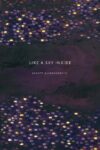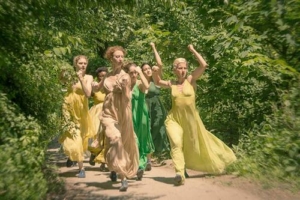 For those readers who are in the New York City area, this Friday and Saturday (June 19th and 20th) will mark the end of a six-week instillation entitled And All Directions I Come to You, by the Atlanta-based artist collective glo. As will become clear below, defining the instillation is a bit of a fool’s errand, but that’s fine, you should go anyway. Speaking very loosely, the work is a six-hour progression through the North Woods of Central Park, which is 90 acres of trees, streams, 400 million year old rock faces, and an active bird sanctuary. Lauri Stallings, glo’s director and the principle artist behind And All Directions I Come to You, describes the work as a “nomadic installation.” At times interactive, at times contemplative, at times drawing on the language of classical dance, at others performance art, the work does strange things to your sense of time, place, and movement. Having been told about it by a friend I went expecting to stay for 30 minutes and ended up following around the nine moving artists for two and a half hours, making me at least 90 minutes late for my original plans.
For those readers who are in the New York City area, this Friday and Saturday (June 19th and 20th) will mark the end of a six-week instillation entitled And All Directions I Come to You, by the Atlanta-based artist collective glo. As will become clear below, defining the instillation is a bit of a fool’s errand, but that’s fine, you should go anyway. Speaking very loosely, the work is a six-hour progression through the North Woods of Central Park, which is 90 acres of trees, streams, 400 million year old rock faces, and an active bird sanctuary. Lauri Stallings, glo’s director and the principle artist behind And All Directions I Come to You, describes the work as a “nomadic installation.” At times interactive, at times contemplative, at times drawing on the language of classical dance, at others performance art, the work does strange things to your sense of time, place, and movement. Having been told about it by a friend I went expecting to stay for 30 minutes and ended up following around the nine moving artists for two and a half hours, making me at least 90 minutes late for my original plans.
The work is made up of a series of systems. Mary Virginia Coleman, a founding moving artist at glo, showed me a list of maybe 60 systems, several of which were highlighted in orange indicating that they were new.
[I spoke with Mary Virginia and Lauri separately, but for the sake of simplicity am using their words together.]
Mary Virginia: We create these systems as individual units or entities, and each have their own identity. We can attach different temperatures, textures, different levels of light with each system, then those systems become material for mixing, they can be pulled apart, they can be layered. Switching into a system mode felt for me as an artist like someone giving me an extra set of hands.
The first one I experienced was called “the people parade.” Having had some trouble locating the work, I finally spotted those chiffon dresses I was supposed to look for by a small pool just outside of the North Woods. What was surprising was that they were not alone, but rather were approaching people in the area and drawing them into a large, rotating circle, in which participants had to negotiate entrance, exit, and movement. And before having a chance to situate myself a moving artist had taken my hand and folded me into the circle as well.
Lauri: What I love about the people parade is that it is vulnerable, not because of the scale, the size, the growth that can happen, but because of the trees in the park. It can only grow so much and then the trees say that this as big as you can get without breaking up the circle. So every weekend we find ourselves bending more and more under this one tree. It’s the bending that becomes a little bit foreign to the public, so we turn it down because of that, we just shut it off.
Lauri calls these “moments of etiquette,” where one part of the work, especially those that include public participation, ends and the moving artists transition to another system.
Lauri trained in the ballet, and most if not all of the moving artists come from a dance background.
Mary Virginia: I’ve been really attracted to the rigor and the form of classical dance, and it’s still really a foundation in the work that we do. We do pliés every day. You’ll often hear in process effacée, or it’s a strange pas de chat. The terminology is so relevant, especially in relation to where the bones are in space. But this work is less confined. The principles are all still there, but they are allowed a little more breathing room, and they can be explosive or more subtle, the feeling of quasi- as opposed to necessarily being something. It’s less rigid, but all the principles are still true.
But being under a roof and under a sky are two very different things.
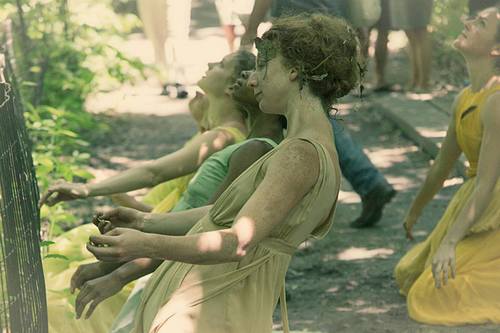
Mary Virginia in foreground, temporarily adorned with a piece of the North Woods
The most familiar artistic medium to the work is that of dance, but this is clearly not just a dance piece. Lauri described writing scores for each of the moving artists, and there are moments when the language of painting or sculpture best describes what you are seeing. I asked her how this mixture of forms and mediums came together.
Lauri: It certainly has happened over time. I’m going say it’s happened over five years of really genuine experimentation. The work itself is not apologetic. It is saying, “I am an experiment,” and that’s incredibly liberating. This work has a lot of that emancipation, which I think artists need to think more about, particularly those who are in what’s typically been called the dance profession, or choreography. Whatever they meant they are changing now, particularly choreography. What does choreography mean to a community, that’s a big question I ask myself. When I first asked it I realized I was really short changing the city I lived in [Atlanta]. That propelled me to a lot of listening, a lot of time-based exploration, acknowledging that this form is ephemeral and will not last forever, however acknowledging that every moment that we attach our intentions, our dreams to is important and to be valued in its own right.
We do spend a lot of time working with musicians. Our dearest collaborators are in the hip-hop industry, the symphonic community, and then we have these wacky experimentalists who come in and shake things up. All of those are musicians and all are married to and rigorous about a score. I think they influence me in how I ultimately organize the work, but getting there is a little more precarious, because as you mentioned, there are all these forms that up to now haven’t necessarily been associated with dance. I see this certainly when it comes to time, and the realization that time is incredibly elastic. I see this happening throughout the art world with those who are working with experience as a form and gesture as a medium.
I think that ours is defined slightly on its own though. First of all, migration is one of the key forms that I use. Three or four year ago I could have sworn that we going to turn into Situationists — I felt like our works were all situations. But then I found that there was this strange fire of intimacy, and I needed to keep that light going, so the situation became epic, then I realized that this is doing something very strange to time, and also what we consider allowable, what are the rules between the roles. That is when I started to open myself up to things that were already there historically. Tableau Vivants were the first collaboration between theatre and music with the French and the Italians. The tableau viavants are really exciting for the North Woods, particularly with the 400 million year old rock that is all around, which is mind-boggling. Certainly they draw our attention to surfaces, and that’s a big deal for us, because of the flesh, that is the canvas and the medium. Without flesh I couldn’t do my work.
So it’s precarious, but it’s not complicated. It’s actually quite simple, but these forms are incredibly exciting. Sometimes I feel like a DJ with these multiple forms. Creative Time really challenged me to open up this catalogue.
I asked Mary Virginia about this DJing approach.
Mary Virginia: That’s how we approach movement with Lauri more and more. She has these impulses and rhythms and physical happenings. We take those and mix it with our own, so they are expressed from a very genuine and internal place, but the intentions are kept clear through that idea of mixing and DJing. That’s Lauri’s philosophy, and it was a big turning point in glo’s history — when we shifted from translating movement to mixing movement. It’s a totally different mindset.
During the work I chatted briefly with Lauri and she mentioned that Glo was based out of Atlanta, which was a genuine surprise given the earthy, elemental nature of the work (Atlanta competes with LA as having the worst traffic in the country, which should indicate the city’s relation to nature, to the body). I asked her about her home city.
Lauri: It’s one of the reasons I had to begin glo, to get people out of their cars. The experiment, glo, could not happen, did not happen anywhere else in the world. It had to happen in Atlanta. Atlanta’s this fabulous place for vibration, and we’ve been able to bring this with us. In fact on Saturday we got back to the center, the Harlem Meer boathouse, which is where we begin and end every day, and the boathouse was quaking, there was so much vibration in the space. The residue, the echoing couldn’t find a place to dissipate, to pause — it was really wild, and I got so excited. As you see I’m very much in love with the city I call my home as a person and as an artist.
Atlanta is the space anchor. When I say space I mean the urban anchor to the work, because it’s a very urban place. It likes urbanism, it’s more turned on by it, gets off by it. But it is also home to man’s longing to have a dream and actually work relentless and very gracefully at it, producing one of the few heroes in this world, MLK. We have very few heroes in the world, particularly in America, we’re just this baby. So Atlanta’s one of those babies, but it’s strange because this baby has a really gigantic heart, so it’s got this great beat to it, there’s this rhythm in the city, and that is what glo is essentially putting and offering to the public.
But yes, the traffic, what are we going to do about the traffic? We’re going to go to them, get them off their asses and out of their cars. What does that mean? We’re going to ask Atlanta and the south to consider that laziness is not a virtue. We’re going to ask a lot of them and make sure that along the way they see that we are deeply committed to this, and are working through pleasure. glo has this great persistence to it. I would probably be put on fire if I ask any less of myself, the world, human nature, the human condition — no one would hang around.
Both Lauri and Virginia talked about vulnerability as a central idea in the work. “It’s very intentional that they’re all women,” Lauri told me. “How are we going to be the most powerful, which also means the most vulnerable? It’s going to be all women in that park, which, typically, if you’re there during the day, outside of exhibition hours, the woods are occupied by mostly men. The work is working from a place of power, and that power is vulnerability. Vulnerability as a craft, some may even call it a principle.”
Mary Virginia: Vulnerability was one of the seeds that the creative team started with, long before the moving artists were involved. Thus the chiffon that we are in, it’s the most vulnerable fabric. When you find your navel and your nose to the ground, and you’re in the middle of the woods in Central Park, it’s hard to get more vulnerable than that. There is not a roof over you, so with the rain, the public, or anything else there is an incredible lack of certainty. Things will never go as you planned them.
As Mary Virginia mentions, a key component of this vulnerability, and really the identifying feature of the work were one to stumble upon it in the North Woods, are the dresses worn by the moving artists, pictured below.
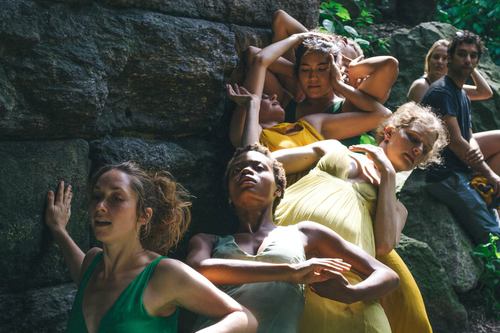
Lauri: The fashion, as in the dresses, they had to be a fabric that could not withstand the weather and the rigor of the work. So it had to be chiffon, there was no other choice. What’s the fabric that needs the most care and a gentle wash, that will change over time and weather, and be very graceful about it, but will show wear, and frankly just show nature? They’re held together in some cases by the will of the thread, so that’s a part of it.
I followed the moving artists for two and a half hours, far longer than a conventional dance performance but also less than half of the total work. I asked Mary Virginia how she and the other moving artists manage to get themselves into a space of concentration that allows them to endures such a lengthy work.
Mary Virginia: The world is constantly trying to distract us, and one of the central elements of the work is a level of attention, which is an inner happening. You could say concentration, but that gives you a feeling of a task or something that has to be done. Attention to something gives the thing that you are focusing on almost more value and using the word attention makes me feel more intimate with things. There is a measure of pleasure and exploration that goes along with it, so the longer you are working inside that level of attention . . . it’s not that it gets easier, but you can go to deeper levels of attention, so you almost want it to keep going. It sounds crazy, but six hours almost isn’t long enough. It becomes a way of existing; a certain state that we’re in when we’re doing the work. It’s not the state I’m in at the supermarket or making mac and cheese at home, but the heart and mind, when utilized with a level of thoughtfulness and attention, they don’t get tired.
The body changes absolutely over time — the muscles get lazier and you don’t have any extra energy to spend. The running, the walking, the breathing, it all becomes more necessary, those things that have to happen as the body gets more exhausted throughout the six hours. But again, the fuel starts coming from other places. This is a philosophy we’ve been working with for a long time: “You have all the time and energy to do whatever you need to do.” It doesn’t always come from the same place. It could be a dream or something particular like a raccoon running by you or a breeze, these outside things, but more it’s something shifting on the inside replenishing you. Will comes into it, and pleasure of course keeps you going.
After having spent so much time, in such a unique way, in the North Woods, I asked Lauri whether she felt a special kinship with Frederick Law Olmstead.
Lauri: I’m in total awe that in the early 1800s they [Olmstead and Calvert Vaux] were using every trick and resource and brilliance to get that park done. I’m thinking about today, when we just put up intentional barricades and “nos” because there’s a laziness to projects like these.
A lot of the original plan that Olmstead and Vaux got approved was actually for a contest, and they won it. I think there was a theatre in the park and a few other more typical things, what you might call landmarks or gathering places, more generic. They put them in and got chosen, and then those things were gone once they got to work. They returned to the need for the park to be designed, not the theatre or fountain. I think at one point they were using the term pleasure-land, which I love. I’m in total awe, particularly of Olmstead, who was very crafty. His level of social consciousness spread out, it was not just about Central Park. It spread to other parts of the country. My city is better for it. One of his last projects was a neighborhood project, which is connected to a very important park in the city. His son designed the major park in Atlanta after Central Park.
But I want to go back to social consciousness and value systems. He was incredibly persistent, and consistent, and I just marvel at that because I see how hard it is today for a group of people to come together and share in an idea and a mission, and very rarely does it happen when it’s benefitting all, not just a few. I wanted offer an experience that I felt might be something like what the first people in the park might experience, certainly not something like “I saw that two years ago.” I wanted them to ask, “What is this? It’s totally fresh, but I don’t know what that means.”
In conjunction with, or as an extension of And All Directions I Come to You, glo has been involved in a series of civic actions in New York City, partnering with the Brooklyn Queens Land Trust, the Washington Heights Expeditionary Learning School, and the West Side Federation for Senior and Supportive Housing.
Mary Virginia: There’s always been a level of civic action with glo’s work, but it’s really developed and come into its own to the point where we recognize it as a central part of the work and things we invest in. I think to Lauri the civic actions are hand in hand with the work now. I’ve actually heard her say we can’t go anywhere and just bring the movement part, there are so many other wings associated with the work because glo cares about people, and one of the beautiful things about the work from the perspective of the moving artist is that you’re brought together with strangers or a family of strangers. People are brought together and they go apart, and there is a sense that the time spent together is important and valuable, and that can be done making paper flowers, that can be done making a movement choir together, that can be done farming. I think farming was an initiative created for In All Directions.
There is a somatic core to the work, and experience is really the medium, making language insufficient in many ways to describe what an artist would want the audience to take away from And All Directions I Come to You. Nevertheless, I asked Lauri what she might hope an audience member would take away from the work.
Lauri: I hope that they perhaps discovered, learned, or grew a new place inside of them, whether it be mental or very emotional. Whatever that place is, it’s something else. Something that perhaps feels foreign to them, like they grew this new limb. That place might be full of questions, it may be full of knowing, and they could have already translated it to remorse, celebration, or fear. There is a lack of comfort to the work that becomes incredibly tender and near romantic, perhaps they find romance with themselves. I want to offer them an inter-subjective experience during and after, that could last a day or last ten years, but something that reminds them, pushes them, does something to them. Particularly in this country there is this paralysis, this numbness, and I think we take it for granted, every single day. Maybe the work has a little instrument, a little something — very kind but very exact. It’s just encouragement, it could be a little stab saying “are you awake, and by the way you are important, we’re here, we’re listening.” I think it’s not something that you hear.
I asked a similar question to Mary Virginia
Mary Virginia: I’ve been on the outside of several works. One of the reasons I’m so personally invested in what we do is that it allows you to be and sit with it and doesn’t require more than that, but offers you the chance to do so much more, to literally intersect with people’s lives. Ninety seconds you spend next to a stranger, they almost feel like blankets in my memory, just from the past five weeks, that add up to feelings that I can’t necessarily categorize or classify, but I know that I value them and they will play a part in interactions or choices that I make later or life. I can assume or only hope that is happening on the other side too.
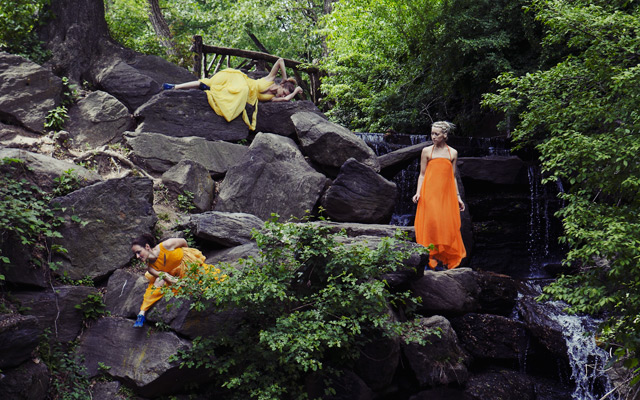
And All Directions I Come to You is part of Drifting in Daylight, a series of works, installations, happenings (there is even soft serve ice cream involved) in the northern section of Central Park. You can read more about the program here.
Michael Schapira is the interviews editor for Full Stop.
This post may contain affiliate links.






